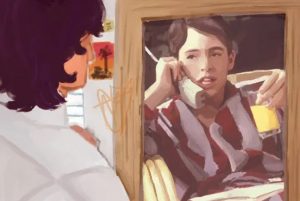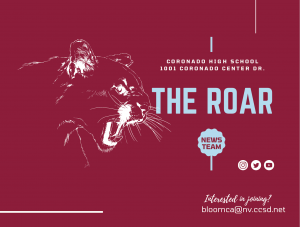
Whatever happened to the teenage dream?// Looking at the mirror, a high school student stares at his reflection and sees his favorite movie character Ferris Bueller. Many high school students who love these films wish that they’d be able to be like their favorite movie characters. (art by Talia Medina)
How Coming-of-age films warped the “high school dream”
by Talia Medina
Coming-of-age films have become a huge part of many teenagers’ lives as they grow up. Teenagers are at a point of time in their lives where they are no longer kids, but not yet adults. Teens often feel that there are some times in their lives when nobody understands them until they see a film that makes them feel seen. However, these films can sometimes give a false impression of the reality they’re about to face growing up.
This genre of film was first introduced with James Dean’s 1955 Rebel Without a Cause, but it didn’t skyrocket into popularity until the 1980s with films being released by director John Hughes becoming a huge hit in the movie theatres. Many teenagers to this day talk about how much his movies, including The Breakfast Club (1985), Pretty in Pink (1986), Ferris Bueller’s Day Off (1986), and more, made them feel seen. The genre once again resurfaced back into fame with the film adaptation of the 1999 book Perks of Being a Wallflower which came out in 2012.
Coming-of-age films typically follow a group of teenagers figuring out their adolescence and could include themes of fitting in, relationships, and even how to skip a day of school while still savoring every moment left that you have before you become an adult. Nonetheless, the films in the 80s became the staple of what many teenage films would be about and began to make many pre-teens believe that just like Ferris Bueller, they would be able to experience thrilling adventures once they reached high school. However, to their dismay, their high school experience would never turn out to be the same as many of their favorite characters.
Teenagers today have come to the heart-breaking realization that many of their favorite characters in the films they’ve been watching have been living in a glorification of what high school is. The biggest example of this problems that many of the characters face will always somehow be solved, even when in reality, they’re problems that could take forever or will never be solved.
The idea of there being “cliques” they should watch out for or should strive to be a part of was also heavily prevalent throughout many of these films and while some of the films tackled this idea by showing that it’s okay to be yourself, there were many that had the message be that you should try to “be popular” and avoid “hanging out with people that were nerds”.
These films take problems like friendship or relationship troubles and make sure that they’re solved within a roughly 90-minute period of time. This idea of problems being able to be solved so quickly caused many adolescents’ ideas of how to handle these issues with what they took in from these films growing up as what high school actually was and what to do when they have a problem with something, which lead to a feeling of confusion about what to do when it wasn’t immediately solved. With it being even more difficult to approach adults, like their parents, on what to do since sometimes communication, especially in a person’s most vulnerable stop in life, usually becomes harsh and feel like several miscommunications could lead to strains in their trust with family.
Coming-of-age films have begun to cause adolescents to only feel seen in the movies they’re viewing and that if they are going through hard times, the best way to solve it is by going on a fun adventure. Even if many of the films can be comforting to watch, many would end up using it as an escape from reality and feel that their family wouldn’t understand it because the generation they grew up with “wasn’t any fun” or that since they’re no longer teenagers, they can’t understand many of the struggles that their child is having.
Films of this genre also include many different types of stereotypes that you’ve seen usually in high school. From the “nerds” to the “popular” kids there is almost always a stereotype for anyone in these films. Many of the more popularized films of the 1980s heavily focus on the idea of wanting to be popular in order to get with the girl of their dreams or to finally feel like they fit in with everyone else. This idea causes many teenagers to try to attempt and go for it because most if not all, their favorite characters succeed in getting what they want. However, this idea can also make teens question why they do not fit in and can even affect how they feel socially and mentally which can also tie into the feeling of being unable to open up about their feelings.
In today’s day in age, coming-of-age films have been more open to exploring the more realistic aspects of being a teenager in high school, like Greta Grewig’s 2017 film Ladybird and Olivia Wilde’s 2019 BookSmart. Many of the films that have glorified and warped the idea of high school are still being praised by many adolescent teens who are about to venture into their high school experience, unaware of how some films may be wrong about what to do as they grow up.











